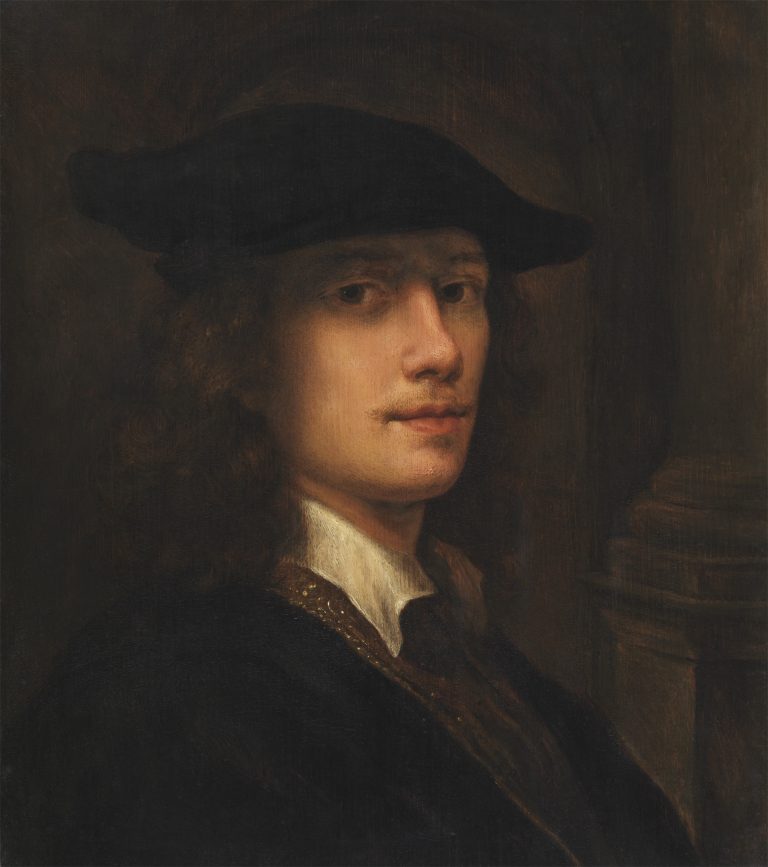The earnest yet slightly bemused young man in this sympathetic portrait bust engages the viewer with a direct gaze. His smooth face and wispy moustache suggest that he is in his late twenties or early thirties, an age appropriate for the stylish notched black beret atop his brown curls. The light illuminating his face and the white, flat collar of his chemise enlivens the scene by accenting the gold or silver piping of his jacket. The base of a Corinthian column, visible at the right in the darkened background, is a pictorial element indicating that—despite his relative youth—he is a man of substance and gravitas.
Tree ring analysis of the panel reveals that the portrait was painted sometime after 1645, a date consistent with the style of the sitter’s long, curly hair and the shirt’s flat collar.1 The manner in which the sitter gazes directly at the viewer suggests that the painting could be a self-portrait, perhaps patterned after one of Rembrandt’s self-portraits of the late 1630s and early 1640s (fig 1). Nevertheless, the smooth, refined brushwork is uncharacteristic of an artist trained in Rembrandt’s workshop. This distinctive stylistic blend of smooth classicism and a Rembrandtesque pose is a fundamental reason for attributing this work to Pieter Verelst, who, in the late 1640s, would have been about 30 years old, the approximate age of the sitter.2 The self-portrait hypothesis is strengthened by the existence of another bust-length portrait, also attributed to Verelst (fig 2), in which the same young man similarly engages the viewer with bold self-confidence.3
Verelst began his artistic career in his native Dordrecht, probably in the mid-1630s. Although it is unclear from whom he learned his craft, given the many connections that existed between Dordrecht artists and Rembrandt’s workshop during the 1630s and 1640s, it is probable that he was trained by an artist familiar with Rembrandt’s stylistic innovations.4 Verelst, who joined the Dordrecht painters’ guild in 1638, was a versatile, even eclectic artist who painted a wide range of subjects in different styles, among them portraits, tronies, and low-life genre scenes. In 1643 Verelst moved to The Hague, where he joined the Guild of Saint Luke that very year. It is not known why he moved there, but it may have been because he believed he could find clients for portraits among those associated with the States General or the court of Stadholder Frederik Hendrik, the Prince of Orange. Indeed, the formal portraits that Verelst painted in The Hague attest to his considerable skill as an insightful portraitist, and his ability to adapt to the courtlier stylistic model of Adriaen Hanneman (ca. 1603/4–71).
After moving to The Hague, Verelst continued to paint images of scholars and hermits, as well as tronies of young boys or old, bearded men situated against a dark background in a Rembrandtesque manner. The portrait in the Leiden Collection fits entirely within that tradition. Although the face is smoothly modeled and the sitter has a dignified and elegant presence, as is appropriate for Verelst’s portrait style in The Hague, the manner in which light falls on his face and the way the beret shades his forehead and eyes fully reflects Rembrandt’s manner. If indeed this is a self-portrait, Verelst’s proud bearing provides a glimpse into the artist’s solid sense of self, one that undoubtedly reflects the optimism he felt in his new artistic circumstances.
In 1656, Verelst’s self-assurance allowed him to join Hanneman and 46 other artists in breaking away from the Guild of Saint Luke to establish the Confrerie Pictura, a new professional organization. While Hanneman served as the Confrerie’s first deacon, the membership regarded Verelst with sufficient respect to have him follow in Hanneman’s footsteps and elect him deacon in 1659–60. Unfortunately, Verelst’s career did not end on a positive note. In November 1668 debts and bankruptcy precipitated Verelst’s sudden departure from The Hague, leaving his creditors a mere 410 guilders worth of possessions.5 Despite the economic decline at the end of his career, this striking portrait is a testament to his artistic skills.
